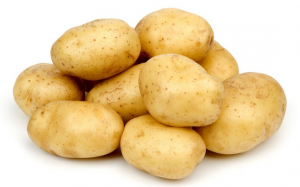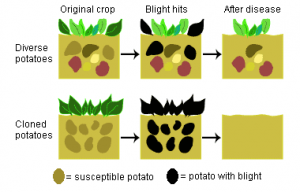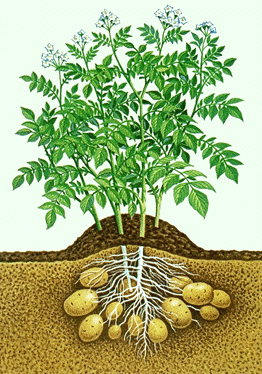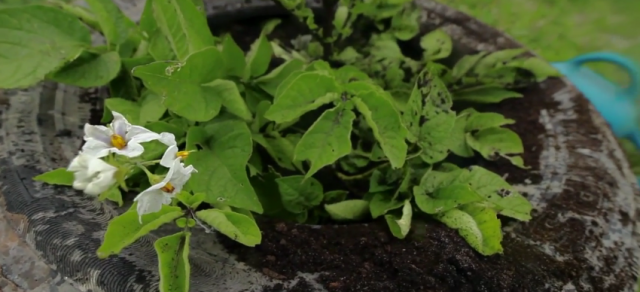 Potatoes are reported to have been domesticated somewhere between 8000 BCE and 5000 BCE. This starchy tuber began its roots in South America and has since spread all around the world, becoming a staple food crop to many cultures.
Potatoes are reported to have been domesticated somewhere between 8000 BCE and 5000 BCE. This starchy tuber began its roots in South America and has since spread all around the world, becoming a staple food crop to many cultures.
The colourful history of the potato has a lot to teach us today. This crop has been under human supervision for generations, and although we made it through the ups and downs, there is still much to learn and improve upon when it comes to proper Potato Damage Control.
 The Great Famine
The Great Famine
 In 1844, Irish newspapers reported a disease which for two years had attacked the potato crops in the United States. That disease was blight; a water mold that formed on the leaf and tuber. Crop loss in 1845, has been estimated at anywhere from one third to as high as one half of cultivated acreage. In 1846, three-quarters of the harvest was lost to blight.
In 1844, Irish newspapers reported a disease which for two years had attacked the potato crops in the United States. That disease was blight; a water mold that formed on the leaf and tuber. Crop loss in 1845, has been estimated at anywhere from one third to as high as one half of cultivated acreage. In 1846, three-quarters of the harvest was lost to blight.
Due to the loss of potato seed, and traditional norms; cloning was implemented heavily in potato farming. These cloned potatoes were at serious risk to blight and played a huge role in the Irish Potato Famine. The overall lack of genetics and variety, in the crops left nothing for the Irish people to fall back on. When blight came to town it left noting behind.
During the famine approximately 1 million people died and a million more emigrated from Ireland, causing the island’s population to fall between 20% and 25%.
 Not all varieties of potatoes were affected by blight. The cross-bred crops with wild potatoes appeared to develop a resistance to the blight disease, while the cloned potatoes weren’t as lucky. As diseases grew and evolved into new forms, the cloned potato stayed the same and eventually could not defend itself against the growing disease.
Not all varieties of potatoes were affected by blight. The cross-bred crops with wild potatoes appeared to develop a resistance to the blight disease, while the cloned potatoes weren’t as lucky. As diseases grew and evolved into new forms, the cloned potato stayed the same and eventually could not defend itself against the growing disease.
Lesson: While cloning has it’s obvious advantages, it is important to recognize the need for living organisms to share genetics and partake in the act of evolution. Diversity, in all its forms is the main ingredient in Damage Control.
Potato Abundance
Now that you understand the importance of having more than one kind of potato, lets find out how to have your potato plant thrive and producing nutritious tubers in abundance.
 Since a potato is made underground, it is important to have optimal growing conditions for the plant. Loose, well drained soil will allow for maximum growth with minimal water logging. High moisture and stagnant water is the number 1 cause of potato blight, also known as water mould.
Since a potato is made underground, it is important to have optimal growing conditions for the plant. Loose, well drained soil will allow for maximum growth with minimal water logging. High moisture and stagnant water is the number 1 cause of potato blight, also known as water mould.
To meet these needs we will use a sandy soil and train the potato plant to grow vertically, burring it’s leaves as it expands. This can be accomplished with a number of different mediums, such as wood, wire and straw or recycled tires. The way you build up your soil and hold it in place is up to you. We happened to use tires but the idea remains the same.
- Start by filling in the first layer with earth and plant your potatoes inside.
- When the potato has grown 8 inches in height, bury 4 inches, leaving the 4 inches exposed.
- Continue stacking and piling earth until the end of the season.
This technique is bound to increase your potato production significantly while giving them some added Damage Control against disease.
Message from Germ : There’s only one way for me to know that you guys LIKE this, and want to see more. With one click you can support this practical knowledge being turned into a full and visual learning experience. We have some great episodes in the works for you, and I hope you continue to check in to get a new dose of Damage Control.
 The practical skills are as endless as nature herself. Everything is a tool to the master who perfects the art of applying what he observes to be true. Having nature work with you is not a thing of myth, and if you follow along with these practical skills you will find yourself surrounded by your allies, in a sea of green.
The practical skills are as endless as nature herself. Everything is a tool to the master who perfects the art of applying what he observes to be true. Having nature work with you is not a thing of myth, and if you follow along with these practical skills you will find yourself surrounded by your allies, in a sea of green.
other Damage Control episodes:
Propogation Station – We learn how to begin a soil matrix where all life can thrive.




Currently growing potatoes under straw mulch having read things about tires releasing toxins….
relevant?
http://www.brightonpermaculture.org.uk/news/11-news/363-growing-food-in-tyres.html
hey bob, we built an earthship and it led us to 2 conclusions. #1 we had excess tires :P and #2 the government made us prove that tires dont leech toxins, ( difficult task ) but the head of environmental waste here in quebec stated in a government release that tires could go 1,000 years without releasing its toxins and therefore safe to bury. we make sure the tire does not receive any direct sunlight by bury it in straw.
personally the chicken wire straw technique is the most pleasing to the eye.
The more applicable information the better Germ! Keep it up man and share the wisdom you’ve gained. I’m “diggin” it… :)
Really appreciate the support Devin; It’s people like you that keeps my fire burning :P
thank you, i was thinking of planting potatoes in my garden but i didnt no how. thaks fot the advises, greeting from Goiânia – Brazil
thanks for reaching out to us :D
send us some pictures of your successful potato crop :D